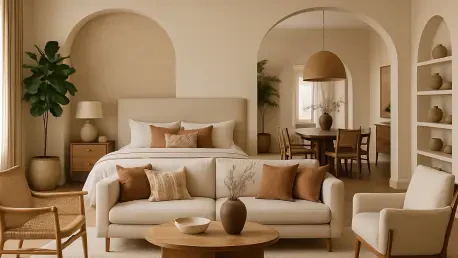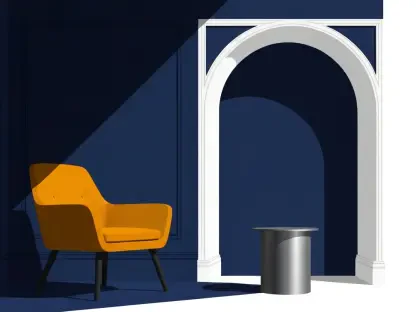A well-layered interior design is both an art and a science, reflecting a delicate blend of personal history, diverse aesthetics, and practical functionality. The amalgamation of materials, textures, and pieces from various eras creates narratives that resonate deeply with individuals, ensuring that spaces stand the test of time. In the case of renowned designer James Thurstan’s Wiltshire home, an African throne chair, a custom sofa, and a reclaimed chestnut coffee table demonstrate the power of mixed elements in crafting an evocative living space. The key to this design approach is finding a harmonious balance between the old and the new, bespoke and antique, capturing stories that define the occupants’ identities.
The Role of Balance in Design
Blending Antiques and Bespoke Elements
Interior design experts suggest a balanced mixture of approximately 40% antiques, 40% bespoke creations, and 20% new pieces, creating a rich tapestry of visual and sentimental appeal. This recommended combination not only ensures a personalized and lived-in atmosphere but also prevents spaces from feeling stuck in the past or overly modern. Emma Burns of Sibyl Colefax & John Fowler emphasizes how antiques infuse a room with historical significance and warmth. By weaving these elements with precision, one can avoid a static ambiance, preserving the room’s vibrancy and preventing it from appearing self-important.
Anna Haines highlights the enchanting allure of antiques, which she often utilizes to enrich interiors with their unique patinas and character. Her selection process involves items like cricket tables that serve as both conversation starters and timeless statements. While approximately 30% of her choices lean towards bespoke furnishings, these are mainly reserved for large items that demand distinctiveness and comfort. The goal is to maintain spatial flow and ensure seamless integration within each room. Incorporating antique mirrors, she finds, can add a touch of character and counteract the sterility often found in newer bathroom designs.
The Importance of Personalization
Laura Hanbury’s approach underscores the significance of tailoring designs to fit specific spatial needs and personal tastes. Her preference for bespoke pieces, which make up around 60% of her design strategy, is influenced by the challenge of sourcing antiques that meet precise dimensional requirements, especially with items like sofas and rugs. At the same time, bespoke designs offer an opportunity to infuse personality and address specific needs. This level of customization is crucial for creating spaces that resonate deeply with their occupants, reflecting individual stories through curated selections.
Wholeheartedly embracing customization, Christian Bense incorporates high custom elements such as tailored cabinetry into his interiors. By doing so, he bridges traditional and contemporary aesthetics, ensuring that each element is cohesive. Through this seamless integration of personalization and thoughtful design, Bense manages to create interiors that feel both fresh and warmly inviting. This pursuit of balance among antique, bespoke, and new pieces fosters a multifaceted environment that appeals on both aesthetic and personal levels.
Crafting Narratives in Interiors
Using Diversity to Enhance Spaces
Layered interiors serve as visual narratives, where diverse elements seamlessly converse to tell a larger story. The process involves sourcing furniture and design elements from a variety of epochs and styles, creating a narrative thread that weaves through each room. This storytelling approach goes beyond mere decoration, offering occupants an immersive experience that resonates with their personal history and sense of identity. By selecting diverse sources, designers infuse spaces with individuality and charm, crafting interiors that are dynamic and reflective of the occupants’ journey.
The consensus among designers is that achieving such diversity and storytelling in design necessitates careful curation and a deep understanding of how different elements interact. By strategically blending different styles, textures, and periods, spaces can evolve organically over time, developing character and depth. This thoughtful amalgamation allows for a room that feels intentionally conceived, yet alive and constantly evolving. Each piece, whether antique or bespoke, becomes a chapter that contributes to the overarching narrative of the space.
The Interplay of Aesthetics and Functionality
Balancing aesthetics and functionality is central to producing timeless designs. A layered interior successfully combines beautiful visuals with practical living solutions, ensuring that spaces are both appealing and comfortable. This approach requires a forward-thinking mindset, considering not just the immediate impact of design choices but also their longevity and adaptability to future needs. By integrating diverse elements that complement each other, designers create spaces that are as functional as they are visually pleasing, enhancing their durability and relevance over time.
Designers understand that a well-executed interior is one where aesthetics and utility go hand in hand. By focusing on quality materials and thoughtful design choices, they craft environments that are resilient to changing trends and lifestyle demands. The outcome is a home that feels personal and evolved, one that tells a continuous story through its layered design. Such a space remains a sanctuary for years to come, embodying the personal expression and creative freedom that guided its creation from the outset.
Reevaluating Timeless Design
Creating a well-layered interior design involves an intricate mix of artistry and practical understanding, reflecting a delicate balance of personal history, diverse aesthetics, and functional needs. This method combines different materials, textures, and elements from various time periods to form stories that deeply connect with those who inhabit the space, ensuring its timeless appeal. An example can be found in the celebrated designer James Thurstan’s home in Wiltshire, where an African throne chair, a custom-designed sofa, and a reclaimed chestnut coffee table illustrate the impact of integrating diverse components into a compelling living area. The essence of this design philosophy lies in achieving a harmonious balance between the old and new, bespoke and antique. Such a synergy not only captures the stories and memories integral to the design but also highlights the identity and essence of its occupants. It’s about creating a space that feels lived in, tells a story, and encapsulates who the residents are.









